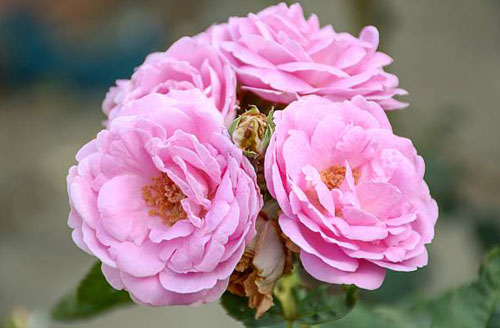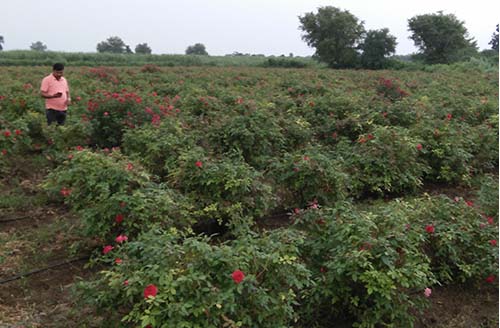Noorjahan, Ranisahiba (CSIR-CIMAP)
Noorjahan (CSIR-CIMAP)
Ranisahiba (CSIR-CIMAP)
Rosa damascena (Damask Rose) is an important species among the scented roses. The plant is a perennial shrub with economic life of over 10 - 15 years. The rose can be grown from 250 to 2500 m altitude in sub tropical to temperate climate. The rose flowers produce highly fragrant and commercially valuable essential oil and its content in the flowers is about 0.025% to 0.030%. About 30-35 q/ha fresh flowers are harvested from one hectare area during month long flowering span which produce 0.90 kg rose oil. The market price of oil ranges between Rs. 9.0 to 10.0 lakh/kg. After deducting all costs, this crop gives an average net return of Rs. 3.10 lakh/ha/year. Other products from damask rose are rose concrete, rose absolute & rose water.
Sub-temperate to tropical climate with a minimum temp of 4-6°C for a month is best suited for the growth of Damask Rose.
Damask rose flourish well at hills and foot hills. It withstands wide range of soil pH conditions from 6 to 8 and silty clay loam to sandy loam soils.
It is propagated through 1 year old stem cuttings, 20-25 cm long of pencil thickness . The lower part of cutting is treated by seradex or 200 ppm of IBA solution and is kept underground for 30 days then transplanted at a distance of 15x15 cm in nursery
Planting can be done in the month of July-August, or October or January. Before planting, 2-3 deep ploughing is must during summer. The soil should be free from weeds and other vegetation. If new land is taken for cultivation, wild bushes and perennial grasses should be cleared. The drainage and irrigation channels are to be made at the same time. For plains, a spacing of 1 x 1 m while in hilly areas, 1.5 through 1 yr old 2.5 m is followed. Pits of 50 x 50 x 50 cm are prepared for planting. During january planting per hill 6 - 8 stem cuttings immediataly after treatment of seradox are planted.
Damask Rose responds very well to manures and fertilizers. In first year 150 kg nitrogen, 80 kg phosphorus and 40 kg potash then in subsequent years, 90 kg nitrogen, 60 kg phosphorus and 60 kg potash is beneficial. After pruning Kinetin 200 ppm should be sprayed 2-3 times at fortnightly interval.
Frequency of irrigation depends on soil type, plant growth stage, and climate First irrigation follows immediately after transplantation. In 1st year 6-7 irrigations are required; later on 1-2 irrigation would be sufficient.
In the 1st year atleast 2 manual weeding and one hoeing, in subseqent years one deep spade hoeing after the pruning of plant 3rd or 4th week of December.
Before sunrise early in the morning.
Instantly after picking of flower. Excess flowers should be spread in a cold room.
Fresh flowers: 3-3.5 ton flower/ha and oil yield – 600-900 gm/ha.
Cost of cultivation : Rs. 1,54,000/ha/yr
Gross return : Rs. 7,60,000/ha/yr
Net profit : Rs. 6,06,000/ha/yr




